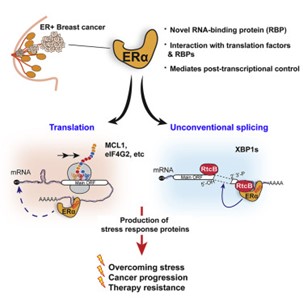Breast cancer is the most common cancer diagnosed in women worldwide, and an estrogen receptor known as ERα plays a critical role in more than 70% of these cancers. In healthy cells, when bound to estrogen, ERα activates a signaling pathway that controls cell growth, proliferation, and survival. In breast cancer, an abnormal variant of ERα sends this pathway into overdrive. For patients with ERα-positive breast cancer, estrogen-blocking hormone therapies like tamoxifen can prolong survival. Up to half of these patients will acquire resistance, however, creating an urgent need for novel treatment strategies targeting ERα.

For thirty years, ERα has been studied solely as a transcription factor, or a protein that “turns on” growth-related genes. But a recent discovery by current Damon Runyon Fellow Yichen Xu, PhD, at the University of California, San Francisco, has unveiled a hidden role for ERα in breast cancer development. Dr. Xu discovered that ERα binds not only to DNA to facilitate transcription but also to messenger RNA (mRNA), where it plays a role in the post-transcriptional processes of splicing and translation. Splicing is the removal of non-coding regions of mRNA and stitching together of the coding regions. Translation is the process by which spliced mRNAs are used as instructions to make proteins. In ERα-positive breast cancer cells, the aberrant ERα hijacks these processes, splicing and translating genes to produce stress-response proteins that help cancer cells adapt to drug-induced stress.
Dr. Xu’s discovery helps explain how ERα-positive breast cancer cells survive hormone therapy. While estrogen blockers reduce ERα’s ability to bind DNA, ERα continues to carry out its RNA-binding activities, making proteins that help cancer cells overcome stress and continue to grow. Excitingly, the researchers found that targeting ERα’s RNA-binding activity indeed renders tamoxifen-resistant cells sensitive to tamoxifen.
This work not only paves the way for novel therapeutic strategies against ERα-positive breast cancer, but also draws attention to the post-transcriptional processes underlying cancer progression and drug resistance. If ERα is any indication, other transcription factors may have more expansive roles than originally thought.
This research was published in Cell.







